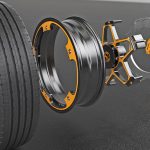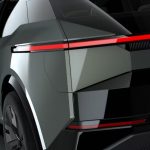The range of electric cars depends heavily on external factors such as temperature, terrain, and air resistance. Recently, Hyundai has introduced the AAS (Active Air Skirt) technology – a new solution to enhance the aerodynamics of electric cars, thereby helping them go faster and farther.
Developed by the Hyundai Motor Group (including Hyundai, Kia, and Genesis), the AAS system is simply a mechanism to lower the air dam in front of the front wheels to minimize the airflow impact on the tires. The dam is activated at speeds above 80 km/h and automatically retracts when the speed drops below 70 km/h. When tested on the Genesis GV60 model, the AAS reduced the drag coefficient (Cd) by 0.008, which is a 2.8% reduction.
As the car travels at higher speeds, the air resistance on the car increases, so the effectiveness of the AAS will be even greater. According to Hyundai, the AAS also helps increase downforce and operates at speeds above 200 km/h. The operation principle of the AAS is similar to the design of racing cars.
Sun Hyung Cho, Executive Vice President and Head of Vehicle Frame Development Group at Hyundai, said: “This technology is expected to have a greater impact on models such as SUVs that are difficult to improve aerodynamic performance.” “We will continue to improve the driving performance and stability of electric vehicles through aerodynamic enhancements.”
Recently, Hyundai has been focusing on developing new technologies for electric cars, and the result is a series of exciting features. One example is the Ioniq 6 electric coupe, which is equipped with active air curtains, wheel wind deflectors, wheel gap reducers, and a rear spoiler, all aimed at reducing drag coefficient.
Currently, AAS is still in the development stage. Hyundai has filed for patents in both South Korea and the United States and plans to apply this technology extensively to its products in the future.
Thái Sơn (Tuoitrethudo)
Reference: Carscoops

























.jpg)

![[CAR REVIEW] Rolls-Royce Spectre: A Symphony of Luxury](https://vnauto.net/wp-content/uploads/2023/10/xehay-rrspectre-30082023-1-150x150.jpg)











